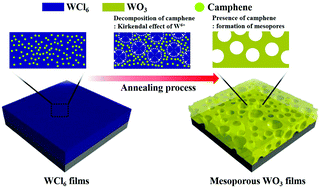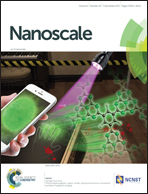Fast-switching electrochromic properties of mesoporous WO3 films with oxygen vacancy defects†
Abstract
In this study, mesoporous WO3 films with oxygen vacancy defects have been fabricated using the camphene-assisted sol–gel method. By controlling the optimized weight ratio of camphene on the WO3 films, we developed a unique film structure of the WO3 phase with both mesoporous morphology and oxygen vacancy defects due to the distinctive effect of camphene. The mesoporous WO3 films with oxygen vacancy defects fabricated using 10 wt% camphene showed superb multifunctional electrochromic (EC) properties with both fast switching speeds (5.8 s for coloration speed and 1.0 s for bleaching speed) and high coloration efficiency (CE, 51.4 cm2 C−1), which include the most prominent properties, particularly for switching speeds among WO3-based films reported so far. The attractive EC properties are due to the synergistic effects of the mesoporous morphology and oxygen vacancy defects on the WO3. The fast switching speeds are mainly caused by the reduced Li+ diffusion pathway due to the mesoporous morphology and increased electrical conductivity due to the oxygen vacancy defects. In addition, the increased CE value is due to the large transmittance modulation as a result of a more effective electrostatic contact of the mesoporous morphology and an increased optical bandgap of the oxygen vacancy defects on the WO3. Therefore, this unique film structure of the mesoporous WO3 films with oxygen vacancy defects can be potentially regarded as a novel EC material for high-performance EC devices.



 Please wait while we load your content...
Please wait while we load your content...